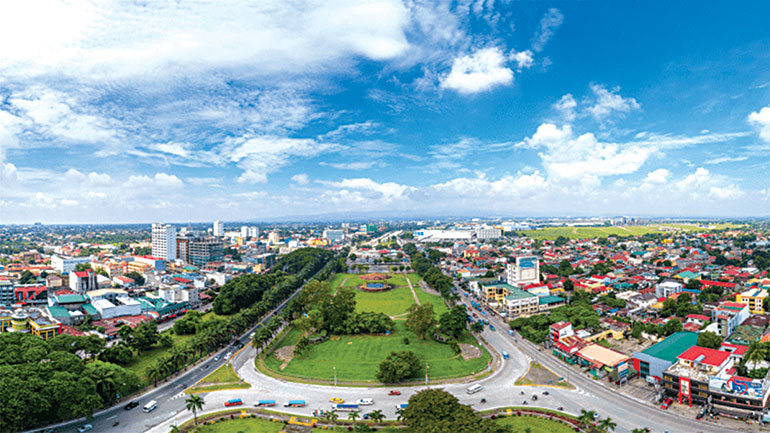From military bases to economic hubs: A legacy of transformation

It is easy to take for granted how much the country has changed over the last twenty years.
Take Bonifacio Global City (BGC), for instance. What was once the heart of a military complex has become one of the most vibrant and economically significant urban centers in the whole country. BGC, carved out of the former Fort Bonifacio military camp, stands today as proof of that transformation — a symbol of what the Philippines has achieved in a few short decades.
The Bases Conversion and Development Authority (BCDA) has been key to that unbridled success. As a government agency tasked with converting former military bases and properties into areas of urban development, BCDA has been instrumental in getting the country to where it is today.
BCDA is a development corporation vested with corporate powers under Republic Act (RA) 7227 (Bases Conversion and Development Act of 1992), signed into law by former President Corazon C. Aquino on March 13, 1992. The BCDA Charter was amended by RA 7917 in 1995, and further amended by RA 9400 in 2007.
BCDA operates at the intersection of public and private sector collaboration, leveraging public-private partnerships (PPPs) to deliver large-scale infrastructure such as expressways, airports, seaports, and real estate developments. It has been instrumental in the implementation of “Build, Build, Build,” the Philippine government’s flagship infrastructure program aimed at reducing congestion, generating employment, and improving cost efficiencies across the country.
Two of the agency’s most notable successes are the aforementioned BGC and the Newport City from the Villamor Air Base.
Covering 240 hectares in Taguig City, BGC is now a bustling financial and lifestyle district, home to corporate headquarters, embassies, luxury residences, and green public spaces. It serves as the base for some of the country’s largest conglomerates and a magnet for multinational companies, creative firms, and startups.
It also serves as a popular hub for foreign investors looking to do business in the country. US Fortune 500 companies like JP Morgan, Tesla, Wells Fargo, and international giants like Samsung all have established bases in the city. That many office spaces in BGC are also accredited by the Philippine Economic Zone Authority — providing incentives to businesses or investors who lease these spaces in the form of tax holidays, discounts and the like — also helps.
“Bonifacio Global City, more commonly referred to as BGC, is one of the most in demand office locations in Metro Manila. Premium leasable office spaces and commercial spaces in this business district are situated in technology-equipped establishments and workspaces capable of supporting top-grade amenities and office functions,” professional services firm KMC Savills noted on its website.

Meanwhile, directly across from Terminal 3 of Ninoy Aquino International Airport, Newport City occupies 25 hectares of what was once part of the military-run Villamor Air Base. Today, it thrives as a compact, high-value township.
Developed by Megaworld Corp., Newport City boasts attractions like Newport World Resorts, one of the country’s first integrated resorts, housing a casino, performing arts theater, hotel cluster, and upscale retail. Around this entertainment nucleus are residential towers, office buildings, and institutional facilities, creating a 24/7 environment for both travelers and residents.
The area’s strategic location has made it a natural hub for business process outsourcing (BPO) firms serving international clients as well, with the airport-adjacent lodging, being a convenient address for global hotel brands operating within or around its perimeter.
Notably, Newport City is also an important proponent of the Philippines’ sustainability agenda, with its Goal Zero Waste Management Program which targets a 90% reduction in landfill contributions. The initiative reflects a broader shift toward environmentally-conscious development, aligning with Metro Manila’s evolving urban priorities.
“Aiming for zero waste in Newport City is a very important achievement that we are eyeing to fulfill in the future. We hope that we all continue to strive to help create a healthier and more sustainable future for more Filipinos, something that we at Megaworld eyes to achieve through our MEGreen program,” Don Earl Caagbay, head of estate management group at Megaworld, had said during the initiative’s launch.
A blueprint for the future
Not to rest on the laurels of success, however, BCDA is today leading the charge in positioning the Clark area in Pampanga as a next-generation investment hub through transformative initiatives like New Clark City — a planned smart, green, and resilient metropolis — and the ongoing expansion of Clark International Airport.
Located across Pampanga and Tarlac, the Clark Freeport and Special Economic Zone (CFEZ) is currently positioning itself as a thriving hub for industries ranging from logistics and manufacturing to tourism and technology.
Clark’s transformation began in earnest in 1993, following the withdrawal of US forces and the designation of the area as a Special Economic Zone. Its strategic location, coupled with generous incentives and modern infrastructure such as the Clark International Airport, quickly made it an attractive destination for both local and foreign investors.
Fast-forward to the first half of 2024, Clark is already home to over 1,155 companies, including major US names such as Texas Instruments, FedEx, UPS, Hilton, and Marriott. Investments in the area have totaled up to $5.70 billion within the same period.
The upcoming Clark CBD is poised to be the largest and most modern central business district in the Philippines. Spanning 100 hectares, it will host commercial, financial, and lifestyle hubs designed to foster economic dynamism and promote a high quality of urban life — much like BGC before it.
As part of its broader mission to develop world-class economic zones and livable urban centers, BCDA is spearheading a portfolio of high-impact infrastructure projects within the area as well.
Positioned within the Clark Civil Aviation Complex, the planned 60-hectare Clark National Food Hub is envisioned as a modern, integrated food terminal, designed to strengthen the country’s agricultural exports, and address issues in food security by improving domestic food supply chains.
Then, there is the vision for the Philippines’ first smart, green, inclusive, and disaster-resilient city, New Clark City. It is projected to be home to over a million Filipinos, with about 60% of its land reserved for forests, green spaces, and public areas.
At 9,450 hectares, it aims to provide seamless connectivity via land, air (Clark International Airport), and sea (Subic Port), positioning it as a future-ready urban center. To support its smart city ambitions, BCDA is also developing future-proof digital infrastructure through an Open Access ICT model. This initiative will enable multiple data transmission providers to operate on shared, carrier-grade broadband infrastructure under equal terms, fostering healthy competition and ensuring affordable, high-quality digital connectivity.
Clark’s appeal also extends beyond its borders. The expansion of urban centers like Porac, as well as improved connectivity via ongoing infrastructure such as the NLEX-SLEX Connector Road and North-South Commuter Railway, has made the wider Pampanga region a focal point of Central Luzon’s economic activity. This makes Clark an integral part of the government’s efforts to decentralize economic growth from Metro Manila for a more financially inclusive country.
Taken together, BGC, Newport City, and Clark reflect the quiet but transformative legacy of the BCDA: converting the remnants of the past into the symbols of the future. — Bjorn Biel M. Beltran



